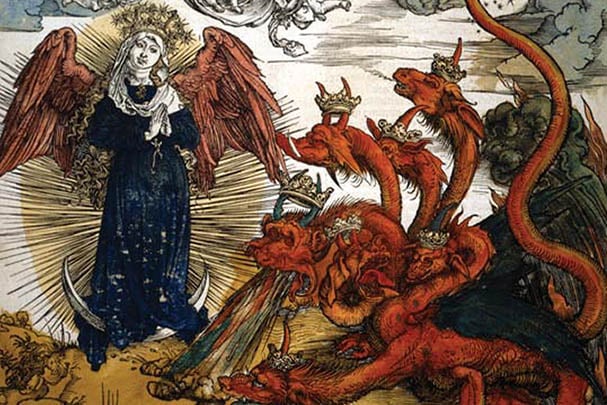This article first appeared in the Practical Hermeneutics column of the CHRISTIAN RESEARCH JOURNAL, volume 38, number 03 (2015). The full text of this article in PDF format can be obtained by clicking here. For further information or to subscribe to the CHRISTIAN RESEARCH JOURNAL go to: http://www.equip.org/christian-research-journal/
The twelfth chapter of Revelation apparently presents a summary of the entire Gospel Age. The chapter opens with the impending birth of a male child, generally recognized as Christ, due to his destiny of ruling the world with a rod of iron (v. 5; cf. Ps. 2:9). A dragon, identified as Satan (v. 9), is seen anticipating the birth, intending to destroy the child (vv. 3–4). The dragon’s failure to achieve its purpose and the catching up of the child to the throne of God (v. 5) result in a battle between Christ’s “brethren” and the dragon (vv. 11, 17), which may depict the age-long spiritual warfare between the church and the forces of darkness.
The first character to appear, and to remain prominent throughout the story, is a pregnant woman (vv. 1–2). She gives birth (v. 5), is then persecuted by the dragon (v. 13), flees to the wilderness (vv. 6, 14), and births additional children (v. 17). Though there is general agreement among commentators concerning the identification of the male child, no such consensus exists in identifying the mysterious woman. She has variously been identified with Israel, with the church, with the believing remnant of the end times, and with the Virgin Mary.
The last of these theories is widely held among Roman Catholics. Its first appearance is found in the speculations of Epiphanias, in the late fourth century.1 It is not the only view espoused by the Roman Church, but it has been endorsed by two popes (Pius X and Paul VI)2 and is probably the most widely embraced view, on a popular level, among Roman Catholics. Having adopted the identification of this woman with the Virgin Mary as a first premise, a number of Roman Catholic doctrines are thought to be justified:
– The equating of Mary with the “new ark of the covenant,” owing to the proximity of this vision with the appearance of the ark in heaven (11:19);
– The exaltation of Mary as a heavenly luminary, since the woman is clothed with the sun, standing in the moon and crowned with stars (12:1);
– The idea that Mary is the “mother,” not only of Jesus but also of all Christians, since they are referred to as “the rest of her offspring” (12:17);
– From the last point, it has been extrapolated that Mary, being “the mother of all living” (Gen. 3:20), should be recognized to be the “new Eve,” whose role in bringing redemption parallels Eve’s role in introducing sin and condemnation.
Most Protestants do not attribute to Mary the status implied in these assertions. However, in dialogue with Roman Catholics, these points often are raised in support of the Marian doctrines, as if the identity of this woman with Mary was an unquestioned starting point for the discussion.
Apart from the question of the woman being, or not being, a reference to the Virgin Mary, it should be pointed out that the proximity, in Chapter 11, of the ark of the covenant provides no basis for an identification of the woman with that object. No suggestion of such a connection can be drawn from any statement in the text. Thus, there would be no exegetical reason to see Christ’s mother as a “new ark,” even if the woman in the following vision could be shown to refer to her.
The evidence that points toward the identifying of the woman with Mary (e.g., that she, in the vision, gives birth to Christ) is inconclusive. After all, in Revelation, the image of a woman needn’t be taken for a literal individual. There is another “woman” portrayed in the seventeenth chapter, who is given the name “Mystery Babylon the Great” (v. 5). Much disagreement over the identity of this “Babylon” has characterized the expositions, but one thing that all agree on is that “Babylon” is not a literal woman. The same may be said for the “bride” depicted in Revelation 21:2, 9–10. This use of female imagery to represent corporate entities in Revelation must inform our interpretation of the woman who bore the male child.
A major clue to her identity, besides her giving birth to Christ, is found in the imagery of the sun, the moon, and the twelve stars (12:1), which clearly hark back to Joseph’s dream in Genesis 37:9. Joseph’s father Jacob recognized these images as representing his own family (i.e., Israel). For this reason, the most ancient interpreters interpreted the woman relative to Israel—usually as the faithful remnant or “spiritual” Israel. The ancient (third century) commentary of Victorinus asserted: “The woman clothed with the sun, and having the moon under her feet, and wearing a crown of twelve stars upon her head, and travailing in her pains, is the ancient church of fathers, and prophets, and saints, and apostles, which had the groans and torments of its longing until it saw…Christ, the fruit of its people according to the flesh.”3 The United States Conference of Catholic Bishops concurs with Victorinus: “The woman adorned with the sun, the moon, and the stars…symbolizes God’s people in the Old and the New Testament. The Israel of old gave birth to the Messiah (Rev. 12:5) and then became the new Israel, the church.”4
However, the Roman Church has come to adopt a double-identification of the woman as representing, on one level, the church, and, on another level, the Virgin Mary: “There is a longstanding tradition of interpretation in the Church which views this woman from two perspectives: as representative of God’s People and as the Mother of our Lord.”5 A respected Catholic commentary explains, “By this woman, interpreters commonly understand the Church….It may also, by allusion, be applied to our blessed Lady.”6
While Protestants may intuit that such a double-identification seems unlikely—and even theologically opportunistic—both ideas have prima facie plausibility. Even if the woman depicts the people of God, as the oldest traditions seem to suggest, it remains possible to see Mary as the individual member of the faithful remnant who brought forth the Messiah. On the other hand, if it is acknowledged that the woman (like other “women” in Revelation) represents a corporate entity, it does not seem necessary to add another layer of interpretation by identifying her with both the corporate church and the individual mother of Christ.
Although the woman’s giving birth to Christ may be one factor that could point to Mary, the subsequent description of the woman’s circumstances would seem to rule out any reference to Mary. The woman is seen as coming under special, post resurrection persecution from the dragon (Rev. 12:13), yet nothing in the Book of Acts, where Mary is last seen (1:14), would indicate that she was singled out from the Christian community in general as a target for persecution.
As a result of this persecution, the vision’s woman flees to, and finds refuge in, the wilderness (Rev. 12:6, 14). Did Mary actually make such a flight? No historical information would suggest that she did so. However, the faithful Jewish remnant (the Judean Church), which in other respects seems a good candidate for identification with the woman, did flee to the wilderness prior to the siege of Jerusalem in AD 70, and so found refuge from the Roman invasion of that city. Eusebius, writing in 325, reports: “The people of the church in Jerusalem had been commanded by a revelation, vouchsafed to approved men there before the war, to leave the city and to dwell in a certain town of Perea called Pella.”7
In Revelation 12:17, the woman is said to have had other “offspring” who experienced persecution with her. While it seems probable that Mary and Joseph had additional children after the birth of Jesus (e.g., Matt. 13:55–56), we do not read of these children experiencing special persecution in the wilderness. On the other hand, if the woman is seen as the Jewish church, then the Gentile Christians, “who keep the commandments of God and have the testimony of Jesus Christ,” would be those referred to as “the rest of her offspring.” The woman, then, is she who is “the mother of us all”—a dignity elsewhere ascribed to “Jerusalem which is above” (Gal. 4:26), which is the church (Heb. 12:22–23).
While the fact of giving birth to Christ would seem to qualify the woman of Revelation 12 to be identified with Mary, there is nothing else in the chapter that would correlate with her, and, as we have observed, there is a tendency in Revelation to use women as figures for some corporate entities rather than for individual persons.
The identification that would better fit all the known facts inside and outside the passage would be that of the faithful Jewish remnant, through whom God brought the Messiah into the world, and which followed Him as His first disciples. The Judean remnant thus became the Judean church. The Book of Acts documents the beginning of the persecution of the woman by the dragon, and church history (Eusebius) records her flight into the wilderness.
This identification easily accommodates the reference to “the rest of her offspring,” since this is a very apt way of speaking of the Gentile churches, which were spawned through the labors of the Judean saints.
As for the idea of a “new Eve,” this would not be at all applicable to Mary, since Adam is a type of Christ (Rom. 5:14), and Eve was Adam’s wife, not his mother. The marriage of Adam and Eve seems to be identified by Paul as a type of Christ and His bride, the church (Eph. 5:31–32), which would, again, make the church, and not Mary, the “new Eve” and “the mother of all living.”
Thus, the identification of the woman with the Virgin Mary is hermeneutically tenuous, rendering this chapter of Revelation useless in the defense of any specific Marian doctrines. —Steve Gregg
Steve Gregg hosts the radio program The Narrow Path (www.thenarrowpath.com) and is the author of Revelation: Four Views (Thomas Nelson, 1997, 2013).
NOTES
- J.N.D. Kelly, Early Christian Doctrines, rev. ed. (San Francisco: HarperCollins, 1978), 495.
- Cited by Fr. John Echert, “Catholic Q and A,” Global Catholic Network, http://www.ewtn.com/vexperts/showmessage.asp?number=385115.
- Victorinus, Commentary on the Apocalypse (online version), http://www.newadvent.org/fathers/0712.htm.
- “Revelation, Chapter 12,” United States Conference of Catholic Bishops, http://www.usccb.org/bible/revelation/12:7.
- Fr. Echert, “Catholic Q and A.”
- Haydock’s Catholic Bible Commentary, 1859 edition (in situ), http://haydock1859.tripod.com/id298.html.
- Eusebius, Ecclesiastical History, Book 3, Chap. 5, in Philip Schaff and Henry Wace, eds., Nicene and Post-Nicene Fathers, Vol. 1 (Second Series) (Peabody, MA: Hendrickson, 1994), 138.









